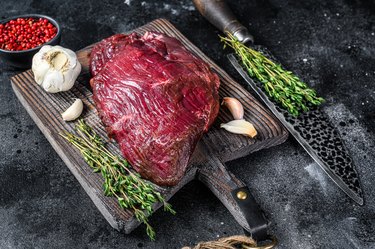
Venison, even from farm-raised deer, is much leaner than conventional beef. This affects how you cook it, because fat is an insulator. The leaner, denser flesh of a deer will cook more quickly than a comparable piece of beef, and requires both a lower temperature and a shorter cooking time.
To prepare a deer roast in the oven, you'll need to reduce the temperature by approximately 25 degrees Fahrenheit to avoid overcooking and toughening the venison. A deer shoulder is relatively fatty, for venison, but will also be tough unless it's slow-roasted for an extended period.
Video of the Day
Video of the Day
Things You'll Need
Venison shoulder roast, approximately 3 to 4 pounds
Paper towels
Heavy skillet
1 tablespoon vegetable oil
Salt and pepper
Other spices, herbs or seasonings, if desired
Pork fat, optional
1 medium onion, diced
1 rib of celery, sliced
1 medium carrot, peeled and diced
Roasting pan with rack
Meat thermometer
Aluminum foil
Instructions
- Wipe down your roast with paper towels to dry the surface and remove any stray bone fragments or other debris left by the butcher. If your deer was wild-caught, check it for shot damage as well.
- Heat a heavy skillet over a medium-high burner until it's hot.
- Add a tablespoon of vegetable oil and sear the roast on all sides, until it's well browned and savory smelling.
- Season the roast liberally with salt and pepper. If you wish to use additional spices, herbs or other seasonings, rub or sprinkle them on at this point.
- Cover the roast with thin slices of pork fat, if you wish, to protect it from drying out during the long cooking process.
- Fill the bottom of a heavy roasting pan with the onions, celery and carrots, a traditional flavoring mixture known by the French name "mirepoix."
- Put the rack into the roaster, jiggling it as necessary to make it fit over the vegetables.
- Place the roast on the rack and transfer the roasting pan to an oven preheated to 275 degrees Fahrenheit.
- Roast at this temperature until the shoulder shows an internal temperature of 135 degrees Fahrenheit when tested with a thermometer. After resting, this will leave the roast rare to medium-rare inside.
- Remove the roast from your oven once it reaches the desired degree of doneness and cover it loosely with aluminum foil.
- Allow the meat to rest for 15 minutes before carving.
Warning
If your venison is wild-caught and you live in an area where trichinosis is a risk, always cook it to well done, or 160 degrees Fahrenheit.